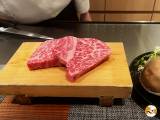The wasabi you know may not be the real thing: here's what you need to know!

If you're a fan of sushi or Japanese cuisine, you've probably already experienced the zesty, vibrant touch that wasabi adds to your dishes. But did you know that what you think is wasabi probably isn't? And yes, according to experts like Japanese chef Hiroko Shimbo and food critic Trevor Corson, the vast majority of the "wasabi" we consume around the world, even in Japan, is really just an imitation made from horseradish, green dyes and Chinese mustard. It is said that 95-99% of the wasabi sold in restaurants is just a cheaper, less authentic version of the famous green paste...
Why this subterfuge?
Real wasabi, in fact, is much rarer and more expensive to produce than you might think. This semi-aquatic herb grows in the mountains of central Japan, where clear, cold water is essential for its growth. It takes several years for the roots to mature, and once grated, they quickly lose their flavor - in less than 15 minutes! Hard luck for wasabi producers, who have had to satisfy an ever-increasing global demand since the sushi explosion of the 2000s. Now you can see why real wasabi remains a niche product...
A unique and inimitable taste
So, what distinguishes real wasabi from its ersatz counterparts? According to Edwin Lee, author of documentaries on Japan, including one on wasabi entitled Wasabia Japonica, real wasabi has an incomparable taste profile. It's this unforgettable taste that is appreciated by those lucky enough to have tasted authentic wasabi, grown according to traditional methods, without chemicals or artificial fertilizers.
In contrast, the current imitation, made essentially from horseradish and colorants, fails to reproduce this complexity. Although pungent, it lacks the depth and freshness that characterize real wasabi.
In conclusion...
The wasabi you know, the one that makes your taste buds tingle and gives you a little kick with your sushi, is probably just an imitation... But don't be too disappointed! Real wasabi, though rare and difficult to produce, offers an unparalleled taste experience that few people are fortunate enough to enjoy. So, even if you're loyal to the green paste on your sushi platter, know that you're probably not tasting wasabi in its purest form!
See also:
 Adèle Peyches
Adèle Peyches


Comments